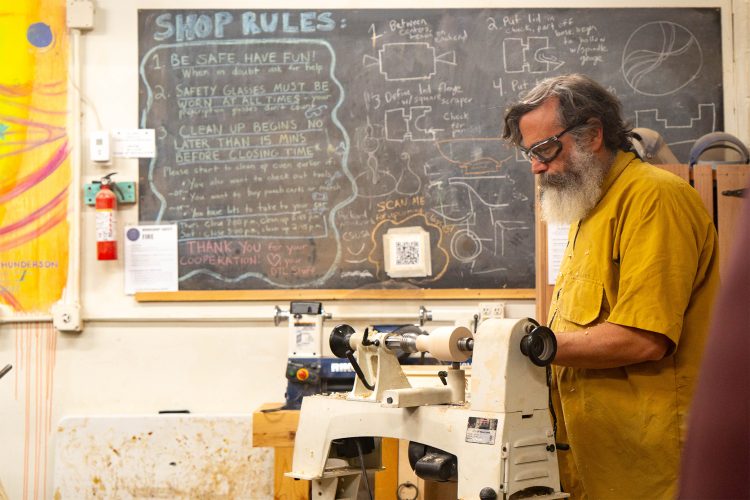In today’s fast-paced world, carving out time for a hobby is less about passing hours and more about reclaiming them. Whether it’s the meditative satisfaction of crafting something by hand or the adrenaline rush of scaling a wall, a fulfilling hobby gives you more than a new skill. It grounds you, fuels creativity, and connects you with like-minded communities. The three activities ahead—leatherworking, climbing, and woodworking—offer the perfect blend of craftsmanship, mindfulness, and challenge to keep both your hands and your brain engaged.

Make It, Wear It, Keep It Forever
Leatherworking is a hands-on hobby that blends precision and imagination to create useful items that last a lifetime. This craft invites you to work deliberately while expressing yourself creatively, whether you’re making a simple luggage tag or an intricately detailed duffel. And the best part? You don’t need a whole workshop to get started. Beginner kits, available at many craft stores and specialty shops, provide all the essential tools, like a mallet, waxed thread, saddler needles, and a sharp knife. Even better, beginner projects don’t require a whole hide; wallets, hat bands, and belts often need a square foot of leather or less.
That said, not all leather is created equal. Leatherworker Jenna Westbrook of Westbrook Findings notes, “Hermann Oak is the best tooling leather because it takes an imprint so much better than other varieties. This makes it much easier to work with.” For sourcing Hermann Oak leather and the necessary hardware, Jenna recommends Springfield Leather Company, Weaver Leather Supply, and Rocky Mountain Leather Supply. Tandy Leather, with multiple locations in Colorado, is another excellent resource for both tools and advice—allowing you to get a feel for the materials in person.
Prefer a collaborative learning environment? Leatherworking classes, including those taught by Jenna at the Arts Students League (check out her Leather Bag Tag class this fall), can be a speedy skill builder. “All of my classes are for beginners,” she explains. “I make sure that people can walk in with no knowledge and get a really thorough understanding of how to work with leather.” Beyond learning, classes connect you with the tight-knit leatherworking community. Whether it’s monthly meetings with a local leather guild (this Denver-based group is dedicated to sharing techniques and supporting fellow leathercrafters), a three-day saddle-making seminar, or annual trade shows across the country, there are countless opportunities to learn, network, and share your passion.
Leatherworking is a craft rooted in tradition yet delightfully niche, offering a unique satisfaction that resonates with makers of all kinds—the joy of creating something meaningful from raw materials with your own hands. “They’re functional objects you interact with every day, and they last forever,” says Westbrook. “Plus, anything I want, I can design and make, and that’s incredibly empowering.” The possibilities of this pastime are endless, limited only by your imagination.

Get a Grip
If you’re looking for a hobby that takes full advantage of Colorado’s breathtaking landscape, climbing is a natural choice. But you don’t have to start on a cliff face—indoor climbing gyms like Denver’s own Übergrippen are a welcoming and accessible way to begin. Übergrippen features over 250 climbing routes and four different styles of climbing: auto-belay (uses a mechanical device to lower you instead of a partner), bouldering (shorter, ropeless climbs over padded floors), top-rope (where a partner manages your rope from the ground), and lead climbing (clipping into anchor points as you ascend). With just a quick ten to fifteen-minute tutorial, complete beginners can get fully oriented with the basics and start climbing right away. The gym also rents out all the gear you’ll need—climbing shoes, harnesses, and more—so you can try out different brands before making any purchases. When you’re ready to invest in your own equipment, check out the ÜG Pro Shop, REI, Neptune Mountaineering, and other local outdoor gear stores.
For those wanting more comprehensive instruction, Übergrippen has you covered: take a Learn to Belay class to master rope handling, or enroll in their four-week 50/50 course, which introduces beginners to climbing techniques, history, and culture while fostering community with a cohort of fellow climbers. This sense of connection is key. “Climbing is a very social activity,” says Grant Farmer, an instructor at Übergrippen. “Even if you’re bouldering and technically don’t need a partner, you still find yourself connecting and sharing with others. It’s a very supportive environment that invites conversation and lifts people up.”
Climbing is rewarding for another reason: “Not only are you getting a fantastic physical workout, but it’s mentally engaging, too,” shares Grant. This hobby builds strength, endurance, and flexibility while demanding focus and creative problem-solving to navigate each route. Whether you’re scaling a boulder at the gym or tackling a granite wall in the Rockies, climbing offers a unique sense of accomplishment and connection—to both the natural world and a passionate community.

Give Lumbar a Legacy
In a world of fast fixes and disposable goods, there’s something deeply satisfying about improving your living space with something lasting and well-made—and woodworking offers exactly that. This hobby builds skills, confidence, and beautiful, functional objects you interact with daily. If you already have basic hand tools, saws, and a workspace, you’re off to a great start. But fear not if your garage isn’t packed with power tools. “Woodworking is a big world,” admits Ian Saunders of Hidden Gnome Woodworking. “It’s hard to narrow it down to just a few tools. But that’s where the Tool Library comes in.”
At the Denver Tool Library, beginners and experienced woodworkers alike can borrow a wide range of tools and use their fully equipped workshop space. It’s an ideal way to get introduced to power tools and experiment with projects without a big upfront investment. Classes centered around beginner-friendly projects like cutting boards and planter boxes are led by skilled woodworkers like Ian and offer guidance in a supportive, low-pressure environment. This hands-on experience helps ease the learning curve. “Your first cutting board might suck, but your second one will be better, and by your fifth, you’ll be really good,” Ian says with a laugh. “Just like with any skill, the more practice you put in, the better you’ll get.”
Best of all, woodworking helps you reconnect with the value of making something yourself. In the time it takes to build a birdhouse or coffee table, you develop patience, problem-solving skills, and an eye for detail. It’s also an invitation to step away from screens and distractions and focus entirely on the material in front of you. “That’s what I love about being in the woodshop: it slows me down,” Ian shares. “I think in our daily lives, we move way too fast. Building something gives you the opportunity to go, ‘This project is going to take me five hours—and that’s okay!’” Woodworking allows you to work thoughtfully and take pride in the process as much as the finished piece. Instead of buying another cheaply made item, try building something better that you’ll be proud of for years to come.



